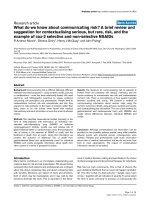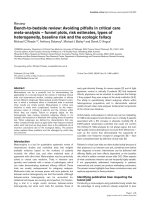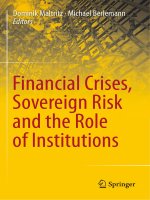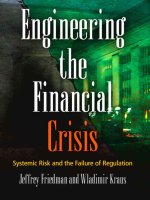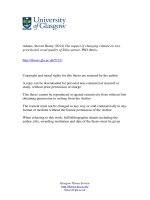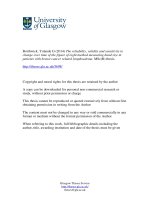CLIMATE CHANGE DISAS CLIMATE CHANGE DISASTER RISK AND THE URBAN POORTER
Bạn đang xem bản rút gọn của tài liệu. Xem và tải ngay bản đầy đủ của tài liệu tại đây (10.42 MB, 322 trang )
CLIMATE CHANGE,
DISASTER RISK,
AND THE
URBAN POOR
Cities Building Resilience for a Changing World
Judy L. Baker, editor
Public Disclosure AuthorizedPublic Disclosure AuthorizedPublic Disclosure AuthorizedPublic Disclosure Authorized
68358
CLIMATE CHANGE,
DISASTER RISK,
AND THE URBAN
POOR
CLIMATE
CHANGE,
DISASTER RISK,
AND THE URBAN
POOR
Cities Building Resilience for a
Changing World
Judy L. Baker, Editor
© 2012 e International Bank for Reconstruction and Development / e World Bank
1818 H Street NW
Washington DC 20433
Telephone: 202-473-1000
Internet: www.worldbank.org
All rights reserved
1 2 3 4 15 14 13 12
is volume is a product of the sta of the International Bank for Reconstruction and
Development / e World Bank. e ndings, interpretations, and conclusions expressed
in this volume do not necessarily re ect the views of the Executive Directors of e World
Bank or the governments they represent.
e World Bank does not guarantee the accuracy of the data included in this work. e
boundaries, colors, denominations, and other information shown on any map in this work
do not imply any judgement on the part of e World Bank concerning the legal status of
any territory or the endorsement or acceptance of such boundaries.
Rights and Permissions
e material in this publication is copyrighted. Copying and/or transmitting portions or
all of this work without permission may be a violation of applicable law. e International
Bank for Reconstruction and Development / e World Bank encourages dissemination of
its work and will normally grant permission to reproduce portions of the work promptly.
For permission to photocopy or reprint any part of this work, please send a request
with complete information to the Copyright Clearance Center Inc., 222 Rosewood Drive,
Danvers, MA 01923, USA; telephone: 978-750-8400; fax: 978-750-4470; Internet: www.
copyright.com.
All other queries on rights and licenses, including subsidiary rights, should be
addressed to the O ce of the Publisher, e World Bank, 1818 H Street NW, Washington,
DC 20433, USA; fax: 202-522-2422; e-mail:
ISBN: 978-0-8213-8845-7
eISBN: 978-0-8213-8960-7
DOI: 10.1596/978-0-8213-8845-7
Cover design: Naylor Design, Inc.
Cover photo: iStockphoto.com
Library of Congress Cataloging-in-Publication Data has been requested
■ v
Foreword xiii
Acknowledgments xv
Abbreviations xvii
Overview 1
Recommended Actions to Build Resilience of the
Urban Poor 2
Chapter 1. Vulnerable Cities: Assessing Climate Change
and Disaster Risk in Urban Centers of the
Developing World 7
Introduction and Objective of the Study 7
Background, Analytical Framework, and Approach 9
Climate Change, Disaster Risk, and Urban Areas:
Assessing Hazard Risk 12
Efforts to Estimate Exposure in Cities 22
Notes 23
References 23
Chapter 2. Vulnerability of the Urban Poor 27
Exposure: Location and Settlement Patterns of the
Urban Poor 28
Climate Change, Disaster Risk, and the Delivery of
Basic Services for the Urban Poor 38
Other Key Issues Affecting the Vulnerability of the
Urban Poor 51
Contents
vi ■ CONTENTS
Notes 58
References 59
Chapter 3. Building Resilience for the Urban Poor 63
Assessing Risk at the City and Community Levels
to Inform Decision Making and Action Planning 64
Integrating Climate Change and Disaster Risk
Reduction Policies for the Poor into Urban Planning
and Management 70
Balancing Policy Tradeoffs among Risk Reduction,
Urban Development, and Poverty Reduction in
Decision Making 76
Strengthening Institutional Capacity to Deliver Basic
Services and Reduce Vulnerability to Climate and
Disaster Risk 86
Bridging Communities and Local Governments to
Work Together on Local Solutions 89
Notes 94
References 94
Chapter 4. Opening New Finance Opportunities for
Cities to Address Pro-poor Adaptation and
Risk Reduction 99
Costing Adaptation and Risk Reduction 100
Sources of Financing for Adaptation and
Risk Reduction 103
Bringing It All Together 121
Notes 122
References 122
Annex 1: Literature Review 125
Linking Climate Change and DRR 128
Climate Change, DRR, and Urban Poverty 128
Service Delivery and the Urban Poor 129
Housing 131
Climate Change: Adaptation and Mitigation 132
Finance 134
Gaps in Existing Literature 134
References 135
CONTENTS ■ vii
Annex 2: Efforts to Estimate Exposure in Cities 141
OECD Study on Ranking Port Cities with High
Exposure and Vulnerability to Climate Extremes 141
Munich Re’s Study on Megacities—Megacities Megarisks 143
GFDRR—Economics of Disaster Risk Reduction 144
Mega-Stress for Mega-Cities: A Climate Vulnerability
Ranking of Major Coastal Cities in Asia 144
Earthquake Disaster Risk Index 145
Multi-Hazard City Risk Index (MHCRI) 145
Note 146
References 146
Annex 3: Learning from Project and Program
Experiences: Individuals, Community, and
Local Government Partnering to Manage Risk 149
Introduction 149
Educate—Good Practices in Knowledge
Sharing and Training 151
Identify—Good Practices in Risk Identifi cation 155
Prepare—Good Practices in Risk Reduction
through Early-Warning Systems 158
Mitigate—Good Practices in Risk Reduction
through Mitigation 160
Flood Management and Urban Planning 160
Water Supply and Sanitation 163
Wastewater Management and Energy 164
Water Supply and Energy Effi ciency 165
Neighborhood Upgrading 166
Job Creation 167
Transfer—Recent Practices in Risk Defl ection 168
Recover—Good Practices in Building-Back-Better 170
Lessons Learned and Recommendations 173
Notes 177
References 177
Annex 4: Dar es Salaam Case Study 181
Overview and Key Findings 181
Case Study Summary 186
Reference 197
viii ■ CONTENTS
Annex 5: Jakarta Case Study 199
Overview and Key Findings 199
Case Study Summary 204
Notes 215
Reference 215
Annex 6: Mexico City Case Study 217
Overview and Key Findings 217
Case Study Summary 220
Notes 233
Reference 233
Annex 7: São Paulo Case Study 235
Overview and Key Findings 235
Case Study Summary 239
Notes 267
Reference 267
Color Section 269
Index 277
Boxes
1.1 Increase in the Number of Heat Waves in the Mexico
City Metropolitan Area (MCMA) 21
2.1 Locating Vulnerable Households in the Mexico City
Metropolitan Area (MCMA) 31
2.2 Jardim Ana Maria: A Slum Pocket in São Paulo 33
2.3 São Paulo’s Geotechnical Hazard Areas and Declivity
Hazard Areas 35
2.4 Pattern between Flood-Prone Areas and Where the Poor
Live in Jakarta 36
2.5 Exposure in Slums of South Asia and Latin America 37
2.6 Water Supply in Dar es Salaam 43
2.7 Water Scarcity in Mexico City 45
2.8 Incidents of Dengue in Jakarta 50
2.9 Settlements and Environmentally Sensitive Lands 52
3.1 Urban Risk Assessment 66
3.2 Lessons Learned from Carrying out City-level Risk
Assessments under the Mayor’s Task Force 67
CONTENTS ■ ix
3.3 Developing Action Plans in Vietnam, New York City,
and Mexico City 68
3.4 Decision Making for Adaptation Planning in Chicago 84
3.5 Robust Decision Making for Road Design in a
Flood-Prone Area 85
3.6 Locally Organized Early-Warning System in Kampung
Melayu in Jakarta 93
4.1 Bangkok’s GHG Emissions and the Clean Technology Fund 106
4.2 Combining Resources to Maximize Synergies: Supporting
Mexico’s Urban Low-Carbon Transformation 107
4.3 MultiCat Mexico 109
4.4 Landfi ll Gas-to-Energy Projects in São Paulo 116
4.5 Tokyo’s Emissions Trading System 117
4.6 Getting Private Water Utilities into Slums: Metro Manila
Water Concessions 118
Figures
2.1 Percentage of Urban Population Using Improved
Sanitation (2008) 44
4.1 Adaptation Cost Curve: Florida Test Case 101
4.2 Benefi t-Cost Ratio by Risk Category for Tunis
and Casablanca 102
A3.1 Examples of Current Good Practices, by Approach to
Risk Management 152
A4.2 Trend of Mean Maximum Temperature Anomalies
during Warm est Months (December–February)
at Dar es Salaam International Airport 193
A4.3 Timeseries of Mean Annual Rainfall in Dar es Salaam 193
A4.4 Mean and Absolute 24 Hours Maximum Rainfall for
Dar es Salaam 195
A4.5 Exposed Population in Dar es Salaam in 2005, 2030,
2050, and 2070 to a 1-in-100-Year Flood under the
A1B Mid-range Sea-Level Rise Scenario, No Adaptation 196
A6.1 Administrative Map of Mexico City Metropolitan Area 220
A6.2 Urban Expansion of Mexico City Metropolitan
Areas, 1950–2005 221
A6.3 90th Percentile of Maximum Temperature, in Celsius,
in 1979–2003 (left) and 2015–2039 (right) 229
A6.4 95th Percentile of Precipitation (mm/day) in 1979–2003
(left) and 2015–39 (right) 230
A7.1 Administrative Map of São Paulo 239
x ■ CONTENTS
A7.2 Growth Rates for City of São Paulo, 1950–2010 240
A7.3 São Paulo City Social Vulnerability Index, IPVS 241
A7.5 Greenhouse Gas Emissions from Electric Energy Use by
Sector in São Paulo 243
A7.6 Transport Use in São Paulo 243
A7.7 Days with Intense Rainfall per Decade 248
A7.8 Number of Flooding Points Registered by CGE in São Paulo per
Year, 2004–2011 248
A7.10 Main Flooding Points of Streets 255
A7.11 Spatial Distribution of Precarious Settlements in City 258
Color Section
A1.1 Population and Megacities in Low-Elevation Coastal Zone
(LECZ) Threatened by Sea-Level Rise and Storm Surges 269
A2.1 Exposure in Large Cities to Cyclones and Earthquakes
Rises from 680 Million in 2000 to 1.5 Billion 270
A4.1 Administrative Map of Dar es Salaam 271
A5.3 Impact of Sea-level Rise on North Jakarta with
Business as Usual 271
A4.6 Map of Flood Hazard Zone Overlaid on Urban Poor
Settlements, Dar es Salaam 272
A5.1 Administrative Map of Jakarta 273
A5.4 Population Exposure to Hazards, Jakarta 274
A5.5 Slum Areas, Flooding and Unregistered Land, Jakarta 274
A6.5 Vulnerable Areas in Terms of Population and Housing,
Mexico City 275
A7.4 São Paulo´s Topography and Main Waterways 275
A7.9 Geotechnical Hazard Areas, São Paulo 276
Tables
1.1 Analytical Framework for Assessing Risk 11
1.2 Hazards Impacting the Urban Poor in Case Study Cities 12
1.3 Summary Findings of Risk Assessments for Dar es Salaam,
Jakarta, Mexico City, and São Paulo 13
1.4 Large Disasters with Major Impacts on Cities,
2000–2010 16
1.5 Global Frequency and Risk of Natural Hazards 17
1.6 Incremental Impacts of Climate Change and Natural Hazards
on Urban Systems and Residents 18
1.7 Major Efforts to Rank Exposure in Cities 22
CONTENTS ■ xi
2.1 Impacts of Recent Disasters in Informal Settlements:
The Philippines 41
2.2 Adaptation Strategies Applied during Heavy Rain 56
3.1 Consequences of Risk-Reduction Policies and Actions in
Urban Areas 78
3.2 Sectors for which Climate Change Should Be Incorporated
Due to Time Scale or Sensitivity to Climate Conditions 83
3.3 Capacity Programs Aimed at Knowledge Sharing, Education,
and Training for Urban Resilience 90
4.1 Current Sources of Financing and Instruments for
Climate Change, Disaster Risk, and Slum Improvements 103
4.2 Summary of Catalytic Financing and Technical Assistance
Programs at the World Bank 108
4.3 Main Instruments for Financing Climate Action in the
Urban Context 111
A2.1 Port Cities with Populations over 1 Million Estimated to
Have Highest Increased Exposure to Surge-Induced Floods,
2005 to 2070 142
A3.1 Matrix of Recent Practice Cases 174
A4.1 Dar es Salaam Profi le 187
A4.2 Natural Hazards 192
A4.3 Effects and Losses 194
A4.4 Signifi cant Floods in Dar es Salaam, 1983–2006 194
A5.1 Jakarta Profi le 205
A5.2 Infrastructure Investments per Year DKI 209
A5.3 Institutional Mapping of Disaster Risk Management
Functions 210
A5.4 Natural Hazards 211
A5.5 Jakarta’s Kota in National Ranking of Kabupaten or
Regencies at High Risk for Various Disasters 211
A5.6 Main Climate Hazards 212
A5.7 Social Assessment 214
A6.1 Mexico City Profi le 222
A6.2 Institutional Responsibilities Relating to Climate
and Disasters 224
A6.3 Status of Main Projects to Adapt to Climate Change 226
A6.4 Natural Hazards 228
A6.5 Vulnerability Matrix in Terms of Population and Housing 231
A6.6 Social Assessment 231
A6.7 Distribution of Vulnerable Groups Located in High-Risk Zones 232
A6.8 Costs in Terms of GDP and Additional Poor 233
xii ■ CONTENTS
A7.1 São Paulo Profi le 240
A7.2 Institutional Mapping of Disaster Risk Management Functions 247
A7.3 Natural Hazards 247
A7.4 Hazards, Effects, and Losses 247
A7.5 Climate Projection for Metropolitan São Paulo 250
A7.6 Incidence of Hazardous Areas in Informal Settlements
in São Paulo 252
A7.7 Degrees of Landslide Hazard 253
A7.8 Cross-Referencing Data: Areas Ranked by Their Critical
Level and Types of Settlements in São Paulo 253
A7.9 Social Assessment 254
A7.10 Houses by Type of Precarious Settlements and
Administrative Regions of City Housing Secretariat 259
A7.11 Access to Urban Services and Infrastructure in
Precarious Settlements in São Paulo 259
A7.12 Number of Precarious Inhabitants per Level of Poverty 260
■ xiii
e number of people living in slums is on the rise all over the developing world.
Increasingly, as cities grow, marginal land is consumed by residents who cannot
a ord to live elsewhere. is land is o en on steep hillsides, ood plains, coastal
zones, or situated near hazardous waste, putting residents at high risk from the
impacts of climate change and natural hazards.
Slum dwellers typically live in poor quality and overcrowded housing, and
have limited access to water, energy, sanitation, and solid waste services. A
heavy rain can quickly turn to a disastrous ood. Such ooding can destroy
the assets of the poor, halt economic activity, destroy their productivity, and
interrupt their income. It can contaminate the water supply, lead to disease, and
displace populations.
is study calls on cities to take a lead role in proactively addressing the risks
of climate change and natural hazards at the local level, with a focus on popula-
tions at highest risk. It suggests a number of actions that cities can take to build
resilience, beginning with mainstreaming pro-poor risk reduction policies into
urban planning and management. Such policies—including those dealing with
land use, relocation, or new development—come with di cult tradeo s that
must be carefully balanced in consultation with stakeholders at the local level.
ey also come with substantial nancing needs that must be met through
public and private resources, and will require new nancing opportunities.
e cities of the Mayor’s Task Force on Climate Change, Disaster Risk, and
the Urban Poor—Dar es Salaam, Jakarta, Mexico City, and São Paulo—provide
examples of good practice at the local level to address risk, through slum upgrad-
ing programs, early warning systems, safety net programs, and adaptation plan-
ning. Such examples demonstrate what is possible when local governments work
across boundaries—both administrative and institutional, and in collaboration
with communities—to develop and implement sustainable solutions.
Foreword
xiv ■ FOREWORD
We invite other cities to share successful examples of programs and policies
that have built resilience for the urban poor so that this knowledge can be broadly
disseminated. We also call upon the development community to work with cities
to identify nancing solutions for the pressing needs that are faced by the urban
poor in today’s changing environment. e World Bank is committed to support-
ing such e orts through both our nancing and our global knowledge products
and services.
Rachel Kyte Sanjay Pradhan
Vice President Vice President
Sustainable Development Network World Bank Institute
e World Bank e World Bank
■ xv
is study was prepared by a team led by Judy L. Baker, lead economist, the
World Bank. Key contributions to the overall study and case studies were pro-
vided by Christa Anderson and Maria Catalina Ochoa. Background papers were
prepared by Anthony Bigio and Stephane Hallegatte (Planning, Policy, Synergies
and Tradeo s for Urban Risk Management, Climate Change Adaptation and Pov-
erty Reduction); JoAnne Carmin, Sabrina McCormick, Sai Balakrishnan, and Eric
Chu (Institutions and Governance in a Changing Climate: Implications for Service
Provision for the Urban Poor); Soumya Dharmavaram (Courting Hazards: Where
the Urban Poor Live); Ari Huhtala, Daniel Hoornweg, and Marcus Lee (Climate
Finance for Cities); Kristina Katich (Beyond Assessment: A Review of Global Best
Practices Addressing Climate Change and Disaster Risk Management for the Urban
Poor, and e Impacts of Climate Change and Disasters on Urban Services); and
David Satterthwaite (How Local Governments Can Work with Communities in the
Delivery of Basic Services). Background research was conducted by Aafrin Kidwai
and Austin Kilroy.
e study was part of the work program of the Mayor’s Task Force on Climate
Change, Disaster Risk, and the Urban Poor, comprising the mayors of Dar es
Salaam, Jakarta, Mexico City, and São Paulo. David Miller, mayor of Toronto
(2003–10) and Chair of C–40 (the Large Cities Climate Change Group) (2008–
10) was an adviser to the Task Force.
e preparation of city-level case studies for Dar es Salaam, Jakarta, Mexico
City, and São Paulo were carried out as part of the work program, with teams
led by each city government. From the World Bank, these studies were led
by Eric Dickson (Mexico City), with Gisela Campillo, Marcus Lee, and Peter
Ellis (Jakarta), and Federica Ranghieri and Andre Herzog (São Paulo and Dar
es Salaam). Each of the case studies has resulted in an individual report that
acknowledges the extensive teams involved in the report’s preparation. e
Acknowledgments
xvi ■ ACKNOWLEDGMENTS
work bene tted from the nancial support and insight provided by Cities
Alliance, the Global Facility for Disaster Risk Reduction, and the World Bank
Institute Climate Change Practice (WBICC).
Peer reviewers included Margaret Arnold, Uwe Deichmann, and Abhas Jha.
Helpful comments were also received from David Miller, Glen Pearce-Oroz,
Apurva Sanghi, and the team members listed above.
e work is a joint e ort by the Finance, Economics, and Urban Department
and the World Bank Institute. e study was carried out under the overall guid-
ance of Zoubida Allaoua, Marianne Fay, Abha Joshi-Ghani, Christine Kessides,
and Konrad von Ritter.
■ xvii
ACCRN Asian Cities Climate Change Resilience Network
ADB Asian Development Bank
ASCCUE Adaptation Strategies for Climate Change in the Urban
Environment
AURAN African Urban Risk Analysis Network
BAPPEDA Badan Perencanaan Pembangunan Daerah (Jakarta)
B/C bene t/cost ratio
BEHD buildings expected to be heavily damaged
BMA Bangkok Metropolitan Administration
BPBD Badan Penanggulangan Bencana Daerah (Jakarta)
BPLHD Badan Pengelola Linkungan Hidup Daerah (Jakarta)
CAT DDO Catastrophe Risk Deferred Drawdown Option
CCRIF Caribbean Catastrophe Risk Insurance Facility
CDCF Community Development Carbon Fund
CDM Clean Development Mechanism
CER certi ed emission reduction
CGE Emergency Management Center (São Paulo)
CIUP Community Infrastructure Upgrading Program
CLACC Capacity Strengthening of Least Developing Countries for
Adaptation to Climate Change
CODEL local emergency committee
COMDEC City Emergency Management Agency (São Paulo)
COP Conference of the Parties
CRC climate resilient cities
CRED Centre for Research on the Epidemiology of Disasters
CTF Clean Technology Fund
CVCCCM Virtual Center on Climate Change for Mexico City
Abbreviations
xviii ■ ABBREVIATIONS
DANIDA Danish International Development Agency
DAWASA Dar es Salaam Water Supply and Sewerage Agency
DCC Dar es Salaam City Council
DKI Special Capital District of Jakarta
DRR disaster risk reduction
ETS emissions trading system
FAR Floor-area ratio
FIP Forest Investment Program
FONDEN Fondo de Desastres Naturales (Mexico)
GDP gross domestic product
GEF Global Environment Facility
GEO-CAN Global Watch Observation Catastrophe Assessment Network
GFDRR Global Facility for Disaster Reduction and Recovery
GHG greenhouse gas
GPOBA Global Partnership on Output-Based Aid
Ha hectare
HABISP Sistema de informações para habitação social (São Paulo)
HRM Halifax Region Municipality
IBGE Instituto Brasileiro de Geogra a e Estatística
IBRD International Bank for Reconstruction and Development
ICLEI Local Governments for Sustainability
IDA International Development Association
IFRC International Federation of Red Cross and Red Crescent
Societies
IIED International Institute for Environment and Development
INPE Instituto Nacional de Pesquisas Espaciais (São Paulo)
IPCC Inter-Governmental Panel on Climate Change
IPT Instituto de Pesquisas Tecnológicas do Estado de São Paulo
IPVS Index of social vulnerability (São Paulo)
ISDR United Nations International Strategy for Disaster Reduction
JMP Joint Monitoring Programme
KICAMP Kinondoni Integrated Coastal Area Management Project
(Tanzania)
LDCF Least Developed Countries Fund
LECZ Low Elevation Coastal Zones
LRAP Local Resilience Action Plan
MAMUCA Mancomunidad de los Municipios del Centro de Atlantida
(Honduras)
MCCAP Mexico City’s Climate Action Program
MCMA Mexico City Metropolitan Area
NAPA national adaptation program of action
ABBREVIATIONS ■ xix
NAP-DRR National Action Plan for Disaster Risk Reduction
NGO nongovernmental organization
NYCPCC New York City Panel on Climate Change
OBA output-based aid
OECD Organisation for Economic Co-operation and Development
OFDA O ce of Foreign Disaster Assistance
OPP-RTI Orangi Pilot Project Research and Training Institute (Pakistan)
PCG partial credit guarantee
Pemprov Provincial Government of the Special Capital District of Jakarta
PHPF Philippines Homeless People’s Federation
PNPM Program Nasional Pemberdayaan Masyarakat (Indonesia)
PPIAF World Bank Public-Private Infrastructure Advisory Facility
PPP public-private partnership
RBF results-based nancing
REDD Reduced Emissions from Deforestation and Forest Degradation
SATKORLAK Satuan Tugas Koordinasi dan Pelaksana (Indonesia)
SEHAB Secretaria da Habitação e Desenvolvimento Urbano (São Paulo)
SLD Shared Learning Dialogue
SMART Sustainable Mitigation and Adaptation Risk Toolkit
SPDMI Strategic Plan for Disaster Mitigation in Istanbul
SVMA Green and Environment Secretariat (São Paulo)
TCIP Turkish Catastrophic Insurance Pool
UNEP United Nations Environmental Programme
UNFCCC United Nations Framework Convention on Climate Change
URA Urban Risk Assessment
VTC Volunteer Technology Community
VUUP Vietnam National Urban Upgrading Program
WDR World Development Report
WHO World Health Organization
WWF World Wildlife Fund
■ 1
Overview
Poor people living in slums are at particularly high risk from the impacts of cli-
mate change and natural hazards. ey live on the most vulnerable land within
cities, typically areas deemed undesirable by others and thus a ordable. Resi-
dents are exposed to the impacts of landslides, sea-level rise, ooding, and other
hazards.
Exposure to risk is exacerbated by overcrowded living conditions, lack of ade-
quate infrastructure and services, unsafe housing, inadequate nutrition, and poor
health. ese conditions can swi ly turn a natural hazard or change in climate
into a disaster, and result in the loss of basic services, damage or destruction to
homes, loss of livelihoods, malnutrition, disease, disability, and loss of life.
is study analyzes the key challenges facing the urban poor, given the risks
associated with climate change and disasters, particularly with regard to the
delivery of basic services, and identi es strategies and nancing opportunities
for addressing these risks. e main audience for this study includes mayors and
other city managers, national governments, donors, and practitioners in the elds
of climate change, disaster-risk management, and urban development.
e work is part of a broader program under the Mayor’s Task Force on
Climate Change, Disaster Risk and the Urban Poor. is task force was launched
at the Mayor’s Summit in Copenhagen in 2009 with the aim to better understand
these issues, identify examples of good practices, and propose policy and invest-
ment programs to improve the resilience of the urban poor. e task force com-
prises the mayors of Dar es Salaam, Jakarta, Mexico City, and São Paulo, who have
recognized the importance of these issues in their cities and have demonstrated
strong support for taking action. In each of the four cities, urban risk assessments
have been carried out that provide the basis for much of the knowledge in the
study. Summaries of those cases are included in annexes 5–7 of this report.
2 ■ CLIMATE CHANGE, DISASTER RISK, AND THE URBAN POOR
e study is organized in four chapters covering (1) a broad look at climate
change and disaster risk in cities of the developing world, with particular impli-
cations for the urban poor; (2) analysis of the vulnerability of the urban poor;
(3) discussion of recommended approaches for building resilience for the urban
poor; and (4) review of the nancing opportunities for covering investments in
basic services and other needs associated with climate and disaster risk.
Several key ndings emerge from the study and provide guidance for address-
ing risk:
• e urban poor are on the front line. e poor are particularly vulnerable to
climate change and natural hazards because of where they live within cities,
and the lack of reliable basic services there.
• City governments are the drivers for addressing risks. Local governments
play a vital role in providing basic services that are critical to improving the
resilience of the urban poor.
• City o cials build resilience by mainstreaming risk reduction into urban
management. Adapting to climate change and reducing disaster risk can be
best addressed and sustained over time through integration with existing
urban planning and management practices.
• Signi cant nancial support is needed. Local governments need to leverage
existing and new resources to meet shortfalls in service delivery and basic
infrastructure adaptation.
Recommended Actions to Build Resilience
of the Urban Poor
ere are a number of actions that can help build resilience for those at greatest
risk in cities. Implementing these actions will involve a strong commitment by
local governments working with communities, as well as national and interna-
tional institutions.
Assessing risk at the city and community levels to inform decision making
and action planning. City-level case studies carried out in Dar es Salaam,
Jakarta, Mexico City, and São Paulo as part of the Mayor’s Task Force program
have demonstrated the importance of understanding environmental, socioeco-
nomic, and institutional risks as an important rst step to developing plans for
adaptation and disaster risk reduction. A risk assessment can de ne the nature of
risks, answer questions about the characteristics of potential hazards, and identify
community vulnerabilities and potential exposure to given hazards. Such infor-
mation helps in prioritizing risk measures, giving due consideration to the prob-
ability and impact of potential events, the cost e ectiveness of the measures, and
resource availability. Experiences from the four task force cities and elsewhere
OVERVIEW ■ 3
also demonstrate that, through the process of assessing risk, it is imperative to
get multiple agencies and community residents involved to exchange ideas, col-
laborate, and communicate with the aim of establishing e ective adaptation and
disaster risk reduction plans.
Integrating policies for climate change and disaster risk reduction for the
poor into urban planning and management. Policies to address climate risks
and natural hazards have links to many sectors and therefore come with impor-
tant synergies that are best captured through systemwide approaches. Compre-
hensive urban planning is thus critical to integrating approaches to addressing
such risks but can o en be challenging, given the many institutions involved in
managing cities. Cities such as London, New York, Quito, and Toronto demon-
strate comprehensive planning approaches that address risk. At a minimum, cit-
ies can identify risk-prone areas and through urban planning discourage new
construction in these areas.
Balancing policy tradeo s among risk reduction, urban development,
and poverty reduction in decision making. Policy decisions typically involve
di cult decisions with outcomes that will have both positive and negative con-
sequences that local decision makers and stakeholders must carefully weigh.
Decisions and investments in public service provision, disaster risk reduction,
and climate change adaptation will have consequences for many decades to
come, given the longevity of many infrastructure investments. Yet these decisions
are particularly sensitive to changes in climate conditions, where there is much
uncertainty. is makes decision making particularly complex and has invoked
some new approaches for policy makers to consider. From an operational per-
spective, policy makers must also consider the context of broader priorities that
involve tradeo s to be balanced.
Better policies for land use planning and management will have the biggest
impact. As cities grow, they expand into marginal areas such as ood plains,
water catchments, and steep hillsides, requiring land-use planning to consider
ood, seismic, and other hazard zones when determining where new develop-
ment should be permitted. E cient transport systems can make land available
in new areas by enabling access and mobility, thereby reducing incentives to
develop in vulnerable locations. Preventing building and settlements in high-risk
areas can save lives and prevent destruction. At the building scale, retro tting of
existing building stock may be necessary, in addition to more robust design stan-
dards for new construction. A framework for the regularization of land tenure,
including partial or incremental solutions, can spur investments and encourage
improvements in infrastructure. Proactive policies can assist in making safe and
a ordable sites available for low-income residents, reducing risk for the poor.
Strengthening institutional capacity to deliver basic services and reduce
vulnerability to climate and disaster risk. In many cities, weak institutional



